Internet of Things and its Impact on Media Convergence & Monopolies
VerifiedAdded on 2023/06/04
|15
|4002
|188
Essay
AI Summary
This essay delves into the transformative impact of the Internet of Things (IoT) on media convergence, control, and the emergence of monopolies. It traces the history of IoT from early machine communication to its modern applications in smart devices and media integration. The essay examines how IoT facilitates media convergence by connecting devices like smartphones and TVs, enabling real-time data access and personalized content delivery. It further discusses the benefits of IoT in media, including enhanced business processes, improved scalability, and the creation of detailed customer profiles. The analysis extends to the concept of media monopolies arising from IoT's integration of various industries, highlighting the advantages of centralized data storage and cloud computing. While acknowledging the benefits, the essay also addresses potential disadvantages such as data overload and privacy concerns. Ultimately, it provides a comprehensive overview of the opportunities and challenges presented by IoT in the evolving media landscape. Desklib offers a variety of study tools, including solved assignments and past papers, to aid students in their academic pursuits.
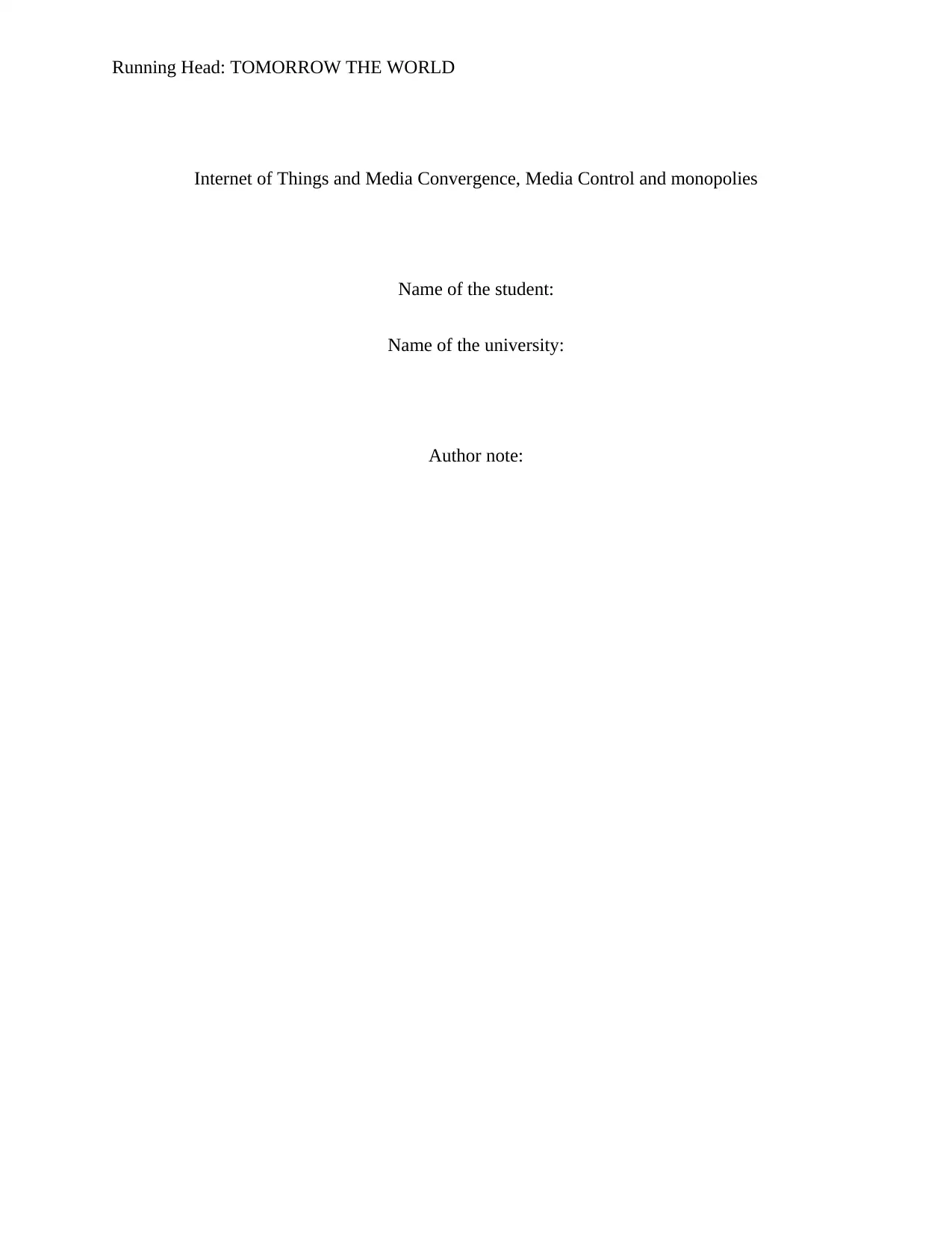
Running Head: TOMORROW THE WORLD
Internet of Things and Media Convergence, Media Control and monopolies
Name of the student:
Name of the university:
Author note:
Internet of Things and Media Convergence, Media Control and monopolies
Name of the student:
Name of the university:
Author note:
Paraphrase This Document
Need a fresh take? Get an instant paraphrase of this document with our AI Paraphraser
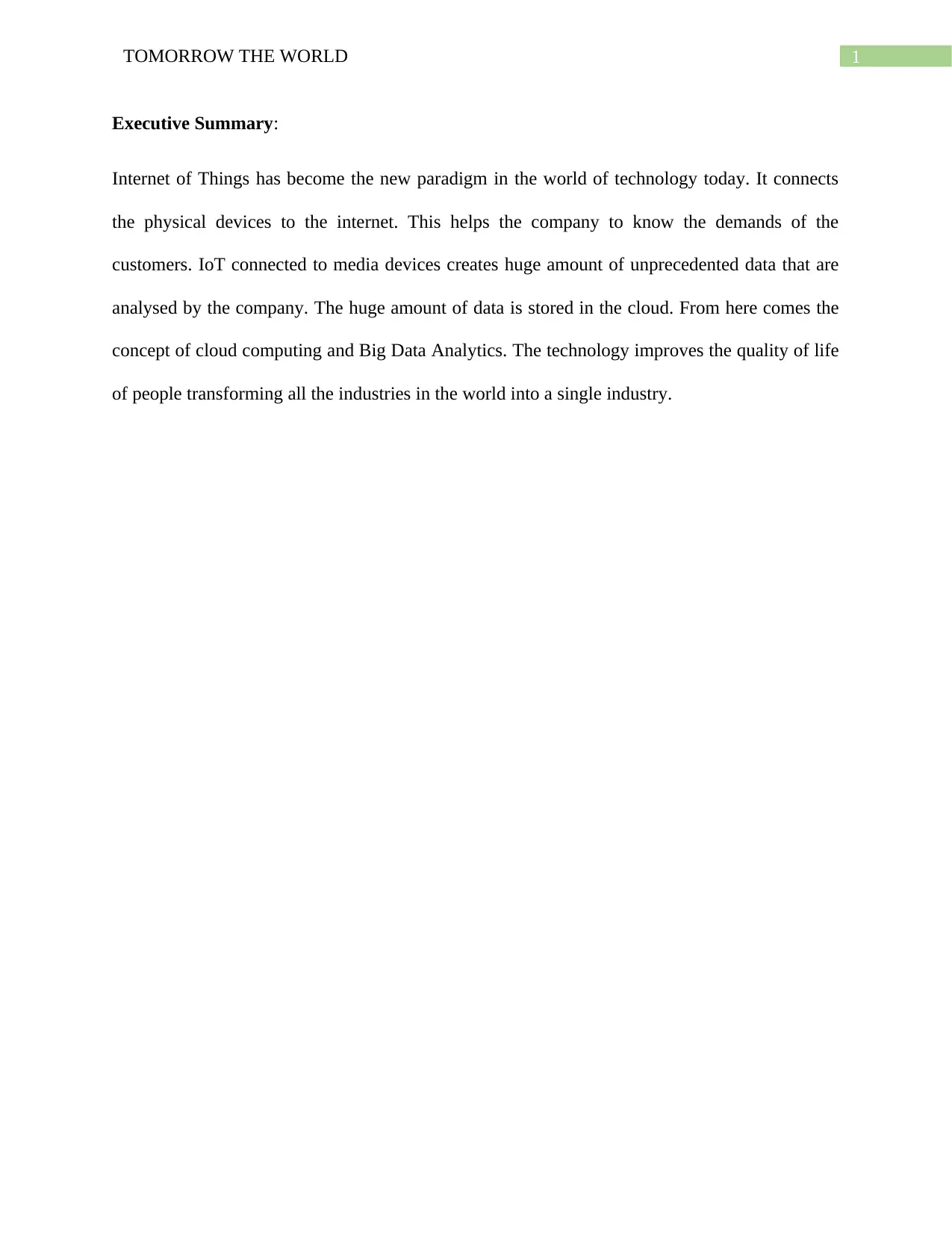
1TOMORROW THE WORLD
Executive Summary:
Internet of Things has become the new paradigm in the world of technology today. It connects
the physical devices to the internet. This helps the company to know the demands of the
customers. IoT connected to media devices creates huge amount of unprecedented data that are
analysed by the company. The huge amount of data is stored in the cloud. From here comes the
concept of cloud computing and Big Data Analytics. The technology improves the quality of life
of people transforming all the industries in the world into a single industry.
Executive Summary:
Internet of Things has become the new paradigm in the world of technology today. It connects
the physical devices to the internet. This helps the company to know the demands of the
customers. IoT connected to media devices creates huge amount of unprecedented data that are
analysed by the company. The huge amount of data is stored in the cloud. From here comes the
concept of cloud computing and Big Data Analytics. The technology improves the quality of life
of people transforming all the industries in the world into a single industry.
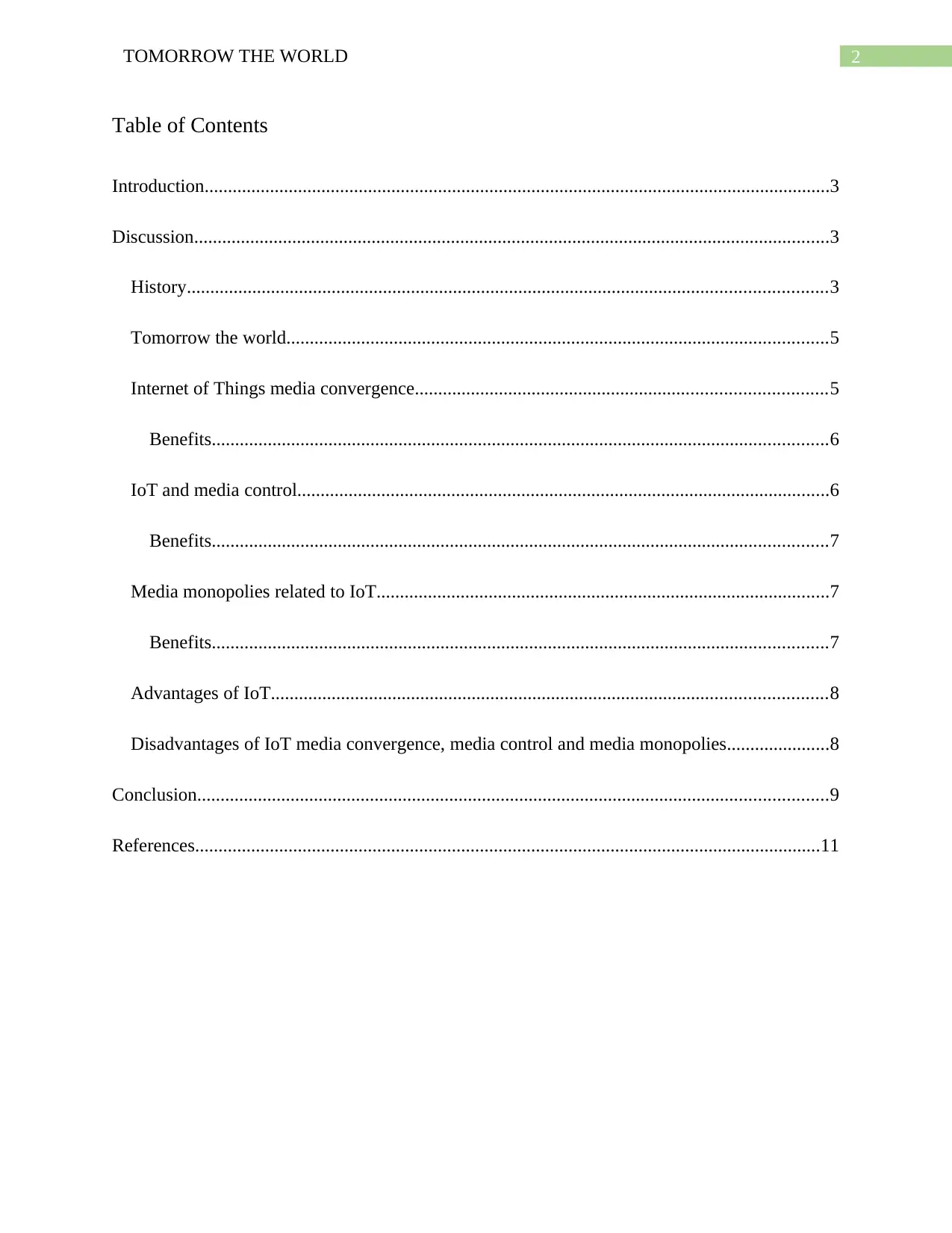
2TOMORROW THE WORLD
Table of Contents
Introduction......................................................................................................................................3
Discussion........................................................................................................................................3
History.........................................................................................................................................3
Tomorrow the world....................................................................................................................5
Internet of Things media convergence........................................................................................5
Benefits....................................................................................................................................6
IoT and media control..................................................................................................................6
Benefits....................................................................................................................................7
Media monopolies related to IoT.................................................................................................7
Benefits....................................................................................................................................7
Advantages of IoT.......................................................................................................................8
Disadvantages of IoT media convergence, media control and media monopolies......................8
Conclusion.......................................................................................................................................9
References......................................................................................................................................11
Table of Contents
Introduction......................................................................................................................................3
Discussion........................................................................................................................................3
History.........................................................................................................................................3
Tomorrow the world....................................................................................................................5
Internet of Things media convergence........................................................................................5
Benefits....................................................................................................................................6
IoT and media control..................................................................................................................6
Benefits....................................................................................................................................7
Media monopolies related to IoT.................................................................................................7
Benefits....................................................................................................................................7
Advantages of IoT.......................................................................................................................8
Disadvantages of IoT media convergence, media control and media monopolies......................8
Conclusion.......................................................................................................................................9
References......................................................................................................................................11
⊘ This is a preview!⊘
Do you want full access?
Subscribe today to unlock all pages.

Trusted by 1+ million students worldwide
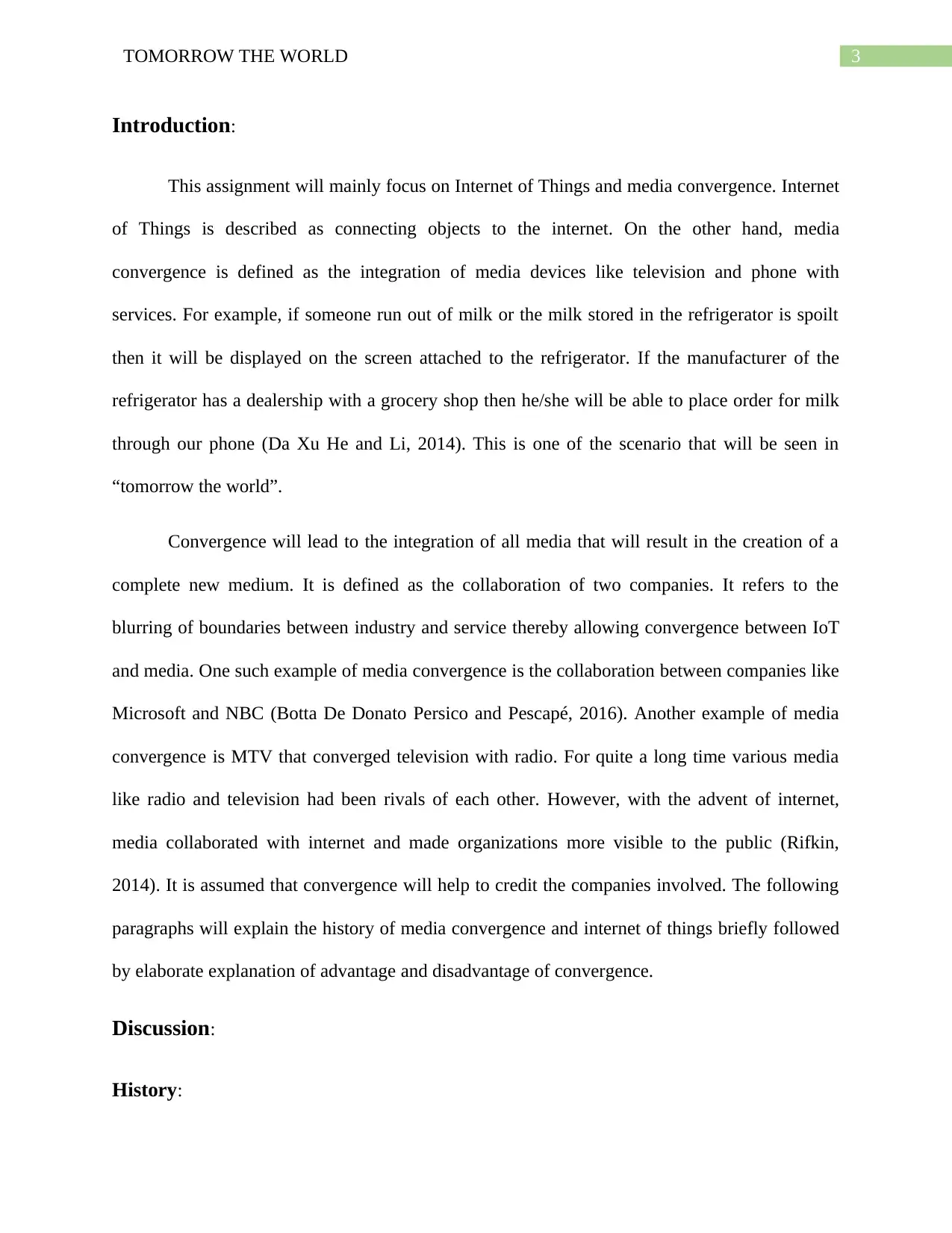
3TOMORROW THE WORLD
Introduction:
This assignment will mainly focus on Internet of Things and media convergence. Internet
of Things is described as connecting objects to the internet. On the other hand, media
convergence is defined as the integration of media devices like television and phone with
services. For example, if someone run out of milk or the milk stored in the refrigerator is spoilt
then it will be displayed on the screen attached to the refrigerator. If the manufacturer of the
refrigerator has a dealership with a grocery shop then he/she will be able to place order for milk
through our phone (Da Xu He and Li, 2014). This is one of the scenario that will be seen in
“tomorrow the world”.
Convergence will lead to the integration of all media that will result in the creation of a
complete new medium. It is defined as the collaboration of two companies. It refers to the
blurring of boundaries between industry and service thereby allowing convergence between IoT
and media. One such example of media convergence is the collaboration between companies like
Microsoft and NBC (Botta De Donato Persico and Pescapé, 2016). Another example of media
convergence is MTV that converged television with radio. For quite a long time various media
like radio and television had been rivals of each other. However, with the advent of internet,
media collaborated with internet and made organizations more visible to the public (Rifkin,
2014). It is assumed that convergence will help to credit the companies involved. The following
paragraphs will explain the history of media convergence and internet of things briefly followed
by elaborate explanation of advantage and disadvantage of convergence.
Discussion:
History:
Introduction:
This assignment will mainly focus on Internet of Things and media convergence. Internet
of Things is described as connecting objects to the internet. On the other hand, media
convergence is defined as the integration of media devices like television and phone with
services. For example, if someone run out of milk or the milk stored in the refrigerator is spoilt
then it will be displayed on the screen attached to the refrigerator. If the manufacturer of the
refrigerator has a dealership with a grocery shop then he/she will be able to place order for milk
through our phone (Da Xu He and Li, 2014). This is one of the scenario that will be seen in
“tomorrow the world”.
Convergence will lead to the integration of all media that will result in the creation of a
complete new medium. It is defined as the collaboration of two companies. It refers to the
blurring of boundaries between industry and service thereby allowing convergence between IoT
and media. One such example of media convergence is the collaboration between companies like
Microsoft and NBC (Botta De Donato Persico and Pescapé, 2016). Another example of media
convergence is MTV that converged television with radio. For quite a long time various media
like radio and television had been rivals of each other. However, with the advent of internet,
media collaborated with internet and made organizations more visible to the public (Rifkin,
2014). It is assumed that convergence will help to credit the companies involved. The following
paragraphs will explain the history of media convergence and internet of things briefly followed
by elaborate explanation of advantage and disadvantage of convergence.
Discussion:
History:
Paraphrase This Document
Need a fresh take? Get an instant paraphrase of this document with our AI Paraphraser
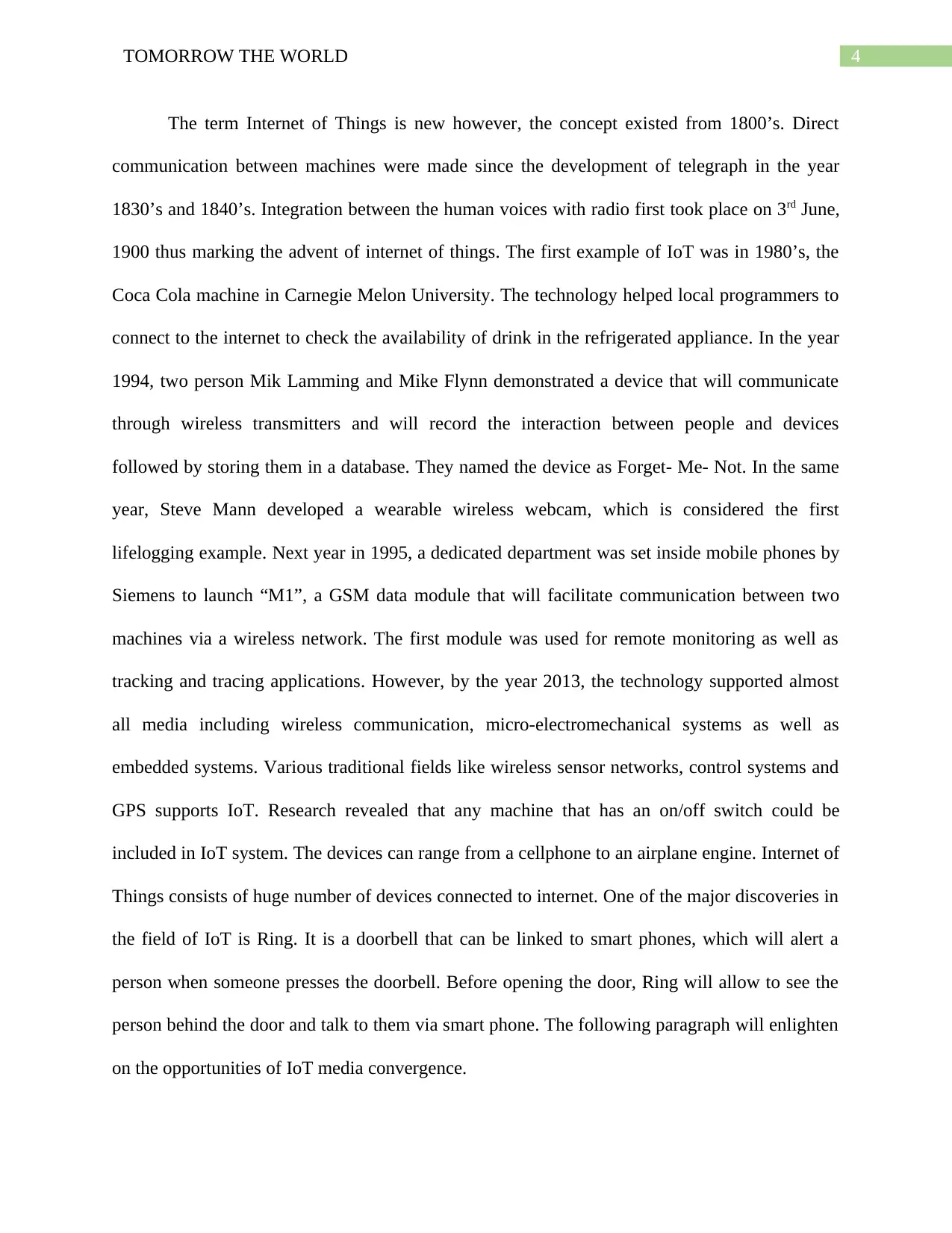
4TOMORROW THE WORLD
The term Internet of Things is new however, the concept existed from 1800’s. Direct
communication between machines were made since the development of telegraph in the year
1830’s and 1840’s. Integration between the human voices with radio first took place on 3rd June,
1900 thus marking the advent of internet of things. The first example of IoT was in 1980’s, the
Coca Cola machine in Carnegie Melon University. The technology helped local programmers to
connect to the internet to check the availability of drink in the refrigerated appliance. In the year
1994, two person Mik Lamming and Mike Flynn demonstrated a device that will communicate
through wireless transmitters and will record the interaction between people and devices
followed by storing them in a database. They named the device as Forget- Me- Not. In the same
year, Steve Mann developed a wearable wireless webcam, which is considered the first
lifelogging example. Next year in 1995, a dedicated department was set inside mobile phones by
Siemens to launch “M1”, a GSM data module that will facilitate communication between two
machines via a wireless network. The first module was used for remote monitoring as well as
tracking and tracing applications. However, by the year 2013, the technology supported almost
all media including wireless communication, micro-electromechanical systems as well as
embedded systems. Various traditional fields like wireless sensor networks, control systems and
GPS supports IoT. Research revealed that any machine that has an on/off switch could be
included in IoT system. The devices can range from a cellphone to an airplane engine. Internet of
Things consists of huge number of devices connected to internet. One of the major discoveries in
the field of IoT is Ring. It is a doorbell that can be linked to smart phones, which will alert a
person when someone presses the doorbell. Before opening the door, Ring will allow to see the
person behind the door and talk to them via smart phone. The following paragraph will enlighten
on the opportunities of IoT media convergence.
The term Internet of Things is new however, the concept existed from 1800’s. Direct
communication between machines were made since the development of telegraph in the year
1830’s and 1840’s. Integration between the human voices with radio first took place on 3rd June,
1900 thus marking the advent of internet of things. The first example of IoT was in 1980’s, the
Coca Cola machine in Carnegie Melon University. The technology helped local programmers to
connect to the internet to check the availability of drink in the refrigerated appliance. In the year
1994, two person Mik Lamming and Mike Flynn demonstrated a device that will communicate
through wireless transmitters and will record the interaction between people and devices
followed by storing them in a database. They named the device as Forget- Me- Not. In the same
year, Steve Mann developed a wearable wireless webcam, which is considered the first
lifelogging example. Next year in 1995, a dedicated department was set inside mobile phones by
Siemens to launch “M1”, a GSM data module that will facilitate communication between two
machines via a wireless network. The first module was used for remote monitoring as well as
tracking and tracing applications. However, by the year 2013, the technology supported almost
all media including wireless communication, micro-electromechanical systems as well as
embedded systems. Various traditional fields like wireless sensor networks, control systems and
GPS supports IoT. Research revealed that any machine that has an on/off switch could be
included in IoT system. The devices can range from a cellphone to an airplane engine. Internet of
Things consists of huge number of devices connected to internet. One of the major discoveries in
the field of IoT is Ring. It is a doorbell that can be linked to smart phones, which will alert a
person when someone presses the doorbell. Before opening the door, Ring will allow to see the
person behind the door and talk to them via smart phone. The following paragraph will enlighten
on the opportunities of IoT media convergence.
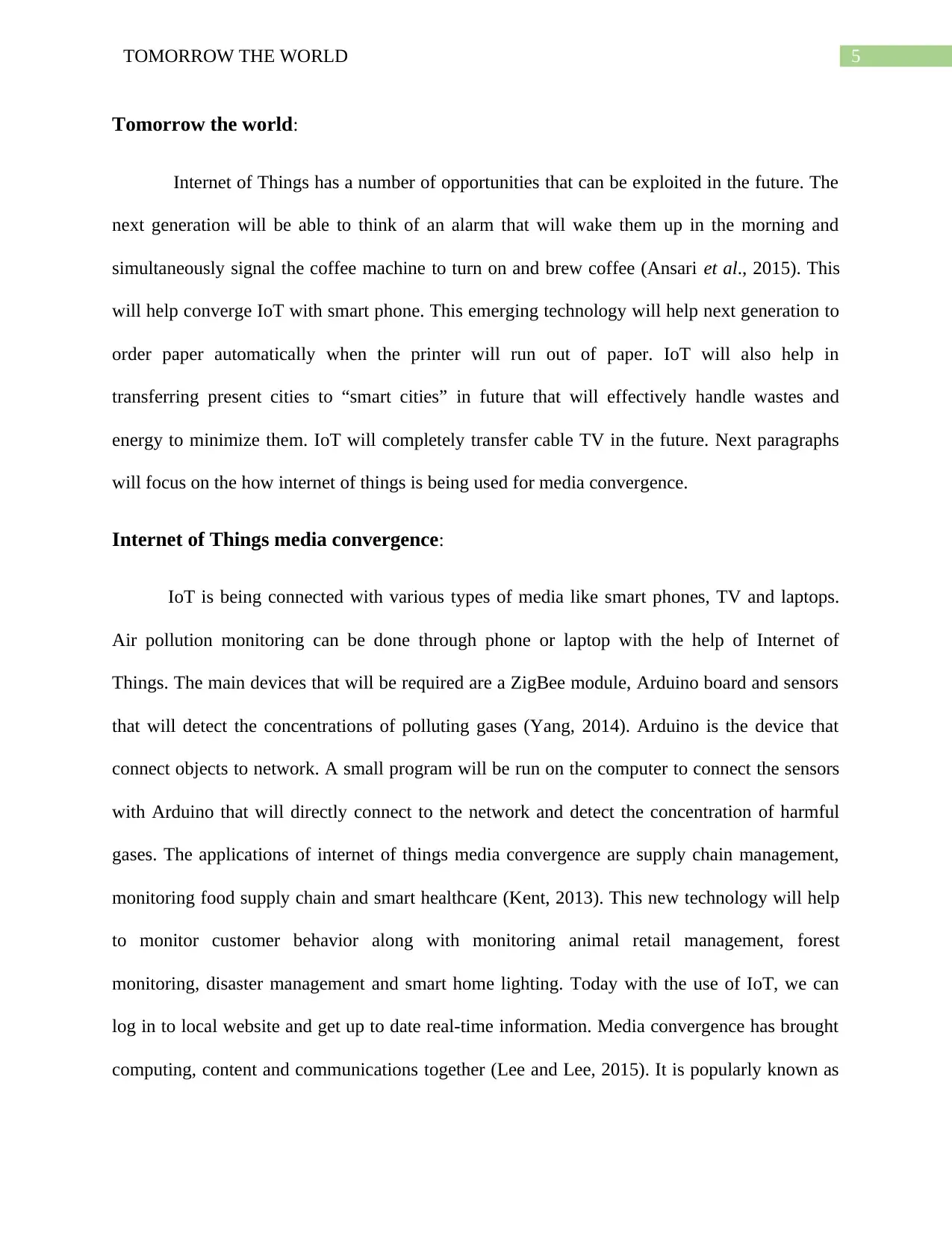
5TOMORROW THE WORLD
Tomorrow the world:
Internet of Things has a number of opportunities that can be exploited in the future. The
next generation will be able to think of an alarm that will wake them up in the morning and
simultaneously signal the coffee machine to turn on and brew coffee (Ansari et al., 2015). This
will help converge IoT with smart phone. This emerging technology will help next generation to
order paper automatically when the printer will run out of paper. IoT will also help in
transferring present cities to “smart cities” in future that will effectively handle wastes and
energy to minimize them. IoT will completely transfer cable TV in the future. Next paragraphs
will focus on the how internet of things is being used for media convergence.
Internet of Things media convergence:
IoT is being connected with various types of media like smart phones, TV and laptops.
Air pollution monitoring can be done through phone or laptop with the help of Internet of
Things. The main devices that will be required are a ZigBee module, Arduino board and sensors
that will detect the concentrations of polluting gases (Yang, 2014). Arduino is the device that
connect objects to network. A small program will be run on the computer to connect the sensors
with Arduino that will directly connect to the network and detect the concentration of harmful
gases. The applications of internet of things media convergence are supply chain management,
monitoring food supply chain and smart healthcare (Kent, 2013). This new technology will help
to monitor customer behavior along with monitoring animal retail management, forest
monitoring, disaster management and smart home lighting. Today with the use of IoT, we can
log in to local website and get up to date real-time information. Media convergence has brought
computing, content and communications together (Lee and Lee, 2015). It is popularly known as
Tomorrow the world:
Internet of Things has a number of opportunities that can be exploited in the future. The
next generation will be able to think of an alarm that will wake them up in the morning and
simultaneously signal the coffee machine to turn on and brew coffee (Ansari et al., 2015). This
will help converge IoT with smart phone. This emerging technology will help next generation to
order paper automatically when the printer will run out of paper. IoT will also help in
transferring present cities to “smart cities” in future that will effectively handle wastes and
energy to minimize them. IoT will completely transfer cable TV in the future. Next paragraphs
will focus on the how internet of things is being used for media convergence.
Internet of Things media convergence:
IoT is being connected with various types of media like smart phones, TV and laptops.
Air pollution monitoring can be done through phone or laptop with the help of Internet of
Things. The main devices that will be required are a ZigBee module, Arduino board and sensors
that will detect the concentrations of polluting gases (Yang, 2014). Arduino is the device that
connect objects to network. A small program will be run on the computer to connect the sensors
with Arduino that will directly connect to the network and detect the concentration of harmful
gases. The applications of internet of things media convergence are supply chain management,
monitoring food supply chain and smart healthcare (Kent, 2013). This new technology will help
to monitor customer behavior along with monitoring animal retail management, forest
monitoring, disaster management and smart home lighting. Today with the use of IoT, we can
log in to local website and get up to date real-time information. Media convergence has brought
computing, content and communications together (Lee and Lee, 2015). It is popularly known as
⊘ This is a preview!⊘
Do you want full access?
Subscribe today to unlock all pages.

Trusted by 1+ million students worldwide
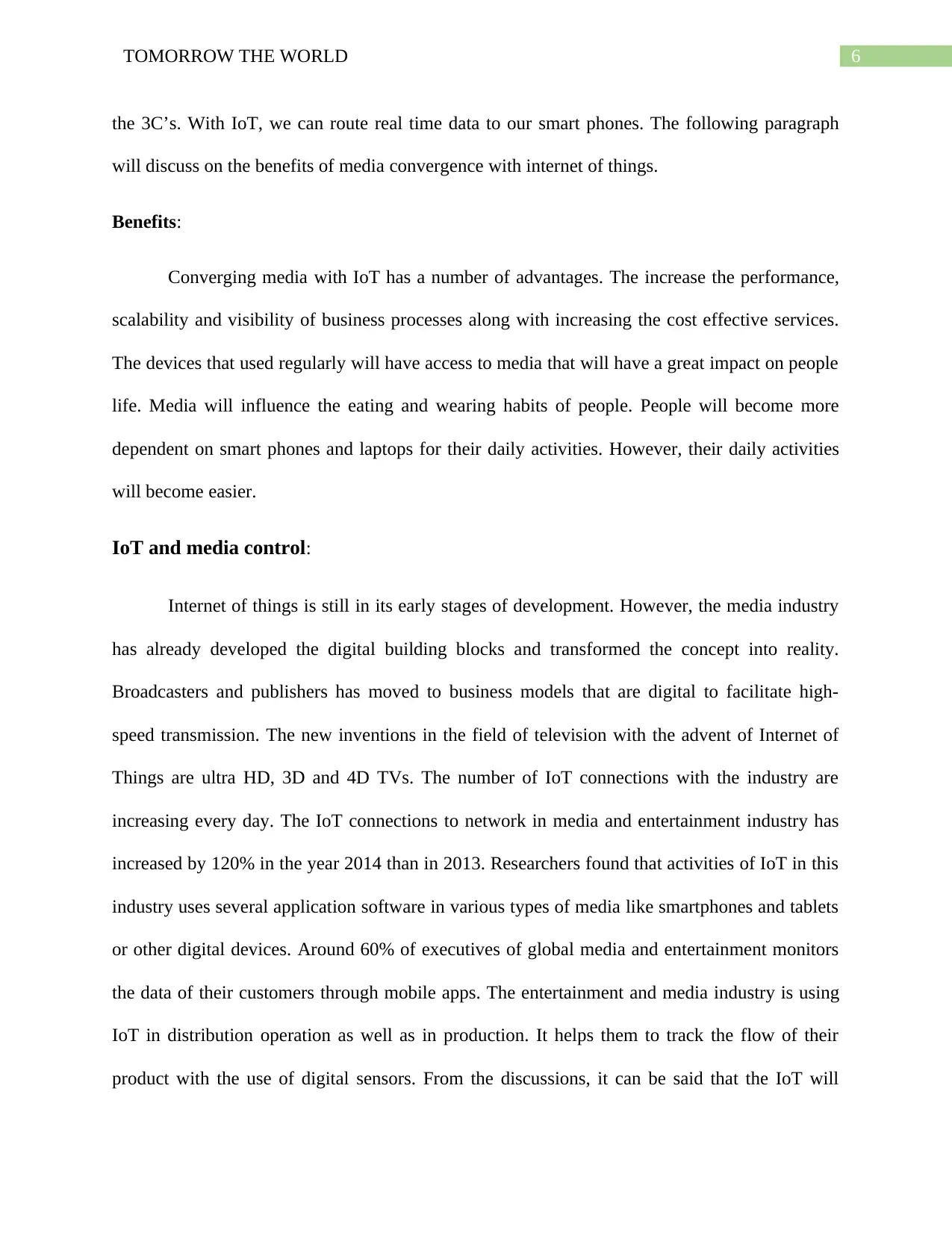
6TOMORROW THE WORLD
the 3C’s. With IoT, we can route real time data to our smart phones. The following paragraph
will discuss on the benefits of media convergence with internet of things.
Benefits:
Converging media with IoT has a number of advantages. The increase the performance,
scalability and visibility of business processes along with increasing the cost effective services.
The devices that used regularly will have access to media that will have a great impact on people
life. Media will influence the eating and wearing habits of people. People will become more
dependent on smart phones and laptops for their daily activities. However, their daily activities
will become easier.
IoT and media control:
Internet of things is still in its early stages of development. However, the media industry
has already developed the digital building blocks and transformed the concept into reality.
Broadcasters and publishers has moved to business models that are digital to facilitate high-
speed transmission. The new inventions in the field of television with the advent of Internet of
Things are ultra HD, 3D and 4D TVs. The number of IoT connections with the industry are
increasing every day. The IoT connections to network in media and entertainment industry has
increased by 120% in the year 2014 than in 2013. Researchers found that activities of IoT in this
industry uses several application software in various types of media like smartphones and tablets
or other digital devices. Around 60% of executives of global media and entertainment monitors
the data of their customers through mobile apps. The entertainment and media industry is using
IoT in distribution operation as well as in production. It helps them to track the flow of their
product with the use of digital sensors. From the discussions, it can be said that the IoT will
the 3C’s. With IoT, we can route real time data to our smart phones. The following paragraph
will discuss on the benefits of media convergence with internet of things.
Benefits:
Converging media with IoT has a number of advantages. The increase the performance,
scalability and visibility of business processes along with increasing the cost effective services.
The devices that used regularly will have access to media that will have a great impact on people
life. Media will influence the eating and wearing habits of people. People will become more
dependent on smart phones and laptops for their daily activities. However, their daily activities
will become easier.
IoT and media control:
Internet of things is still in its early stages of development. However, the media industry
has already developed the digital building blocks and transformed the concept into reality.
Broadcasters and publishers has moved to business models that are digital to facilitate high-
speed transmission. The new inventions in the field of television with the advent of Internet of
Things are ultra HD, 3D and 4D TVs. The number of IoT connections with the industry are
increasing every day. The IoT connections to network in media and entertainment industry has
increased by 120% in the year 2014 than in 2013. Researchers found that activities of IoT in this
industry uses several application software in various types of media like smartphones and tablets
or other digital devices. Around 60% of executives of global media and entertainment monitors
the data of their customers through mobile apps. The entertainment and media industry is using
IoT in distribution operation as well as in production. It helps them to track the flow of their
product with the use of digital sensors. From the discussions, it can be said that the IoT will
Paraphrase This Document
Need a fresh take? Get an instant paraphrase of this document with our AI Paraphraser
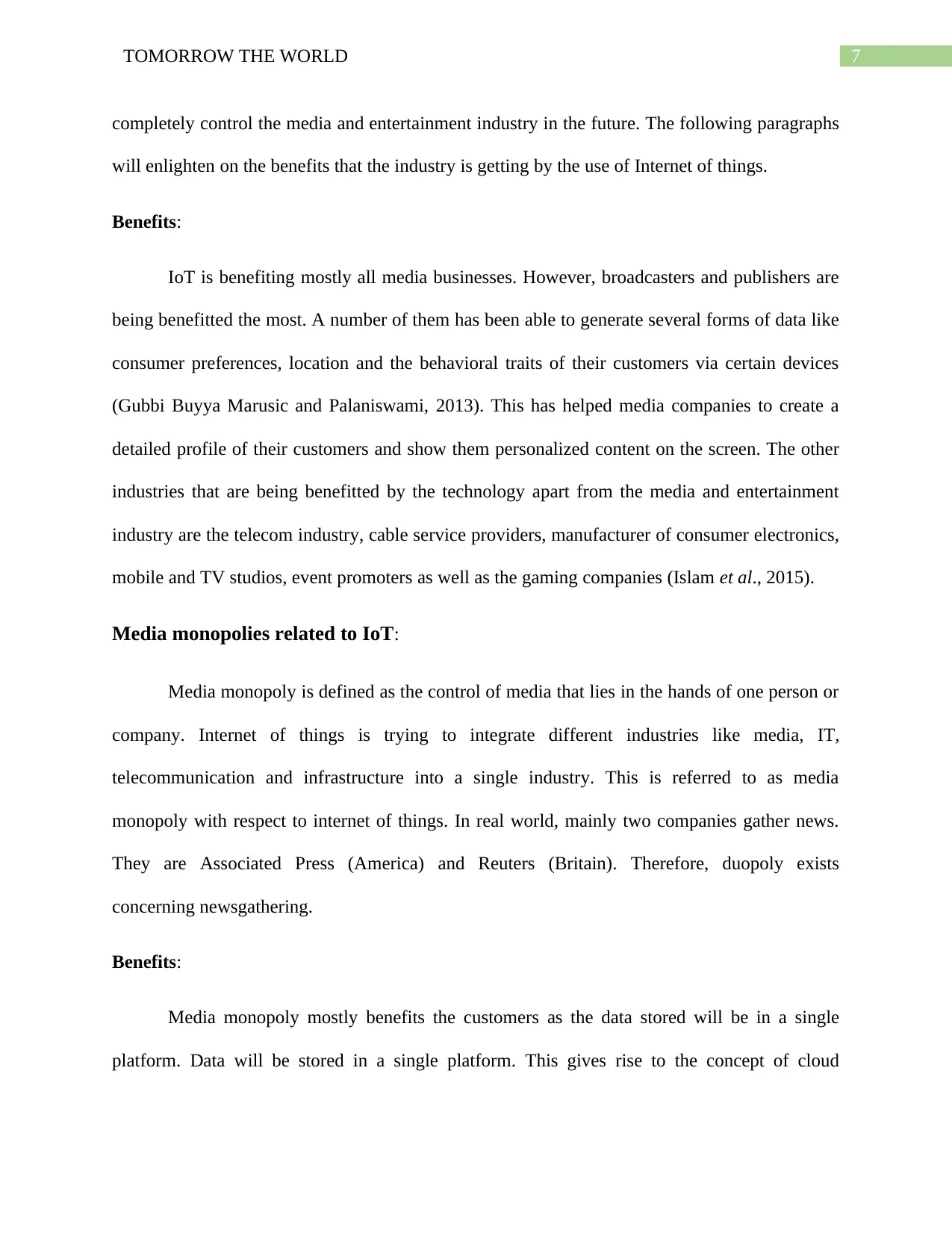
7TOMORROW THE WORLD
completely control the media and entertainment industry in the future. The following paragraphs
will enlighten on the benefits that the industry is getting by the use of Internet of things.
Benefits:
IoT is benefiting mostly all media businesses. However, broadcasters and publishers are
being benefitted the most. A number of them has been able to generate several forms of data like
consumer preferences, location and the behavioral traits of their customers via certain devices
(Gubbi Buyya Marusic and Palaniswami, 2013). This has helped media companies to create a
detailed profile of their customers and show them personalized content on the screen. The other
industries that are being benefitted by the technology apart from the media and entertainment
industry are the telecom industry, cable service providers, manufacturer of consumer electronics,
mobile and TV studios, event promoters as well as the gaming companies (Islam et al., 2015).
Media monopolies related to IoT:
Media monopoly is defined as the control of media that lies in the hands of one person or
company. Internet of things is trying to integrate different industries like media, IT,
telecommunication and infrastructure into a single industry. This is referred to as media
monopoly with respect to internet of things. In real world, mainly two companies gather news.
They are Associated Press (America) and Reuters (Britain). Therefore, duopoly exists
concerning newsgathering.
Benefits:
Media monopoly mostly benefits the customers as the data stored will be in a single
platform. Data will be stored in a single platform. This gives rise to the concept of cloud
completely control the media and entertainment industry in the future. The following paragraphs
will enlighten on the benefits that the industry is getting by the use of Internet of things.
Benefits:
IoT is benefiting mostly all media businesses. However, broadcasters and publishers are
being benefitted the most. A number of them has been able to generate several forms of data like
consumer preferences, location and the behavioral traits of their customers via certain devices
(Gubbi Buyya Marusic and Palaniswami, 2013). This has helped media companies to create a
detailed profile of their customers and show them personalized content on the screen. The other
industries that are being benefitted by the technology apart from the media and entertainment
industry are the telecom industry, cable service providers, manufacturer of consumer electronics,
mobile and TV studios, event promoters as well as the gaming companies (Islam et al., 2015).
Media monopolies related to IoT:
Media monopoly is defined as the control of media that lies in the hands of one person or
company. Internet of things is trying to integrate different industries like media, IT,
telecommunication and infrastructure into a single industry. This is referred to as media
monopoly with respect to internet of things. In real world, mainly two companies gather news.
They are Associated Press (America) and Reuters (Britain). Therefore, duopoly exists
concerning newsgathering.
Benefits:
Media monopoly mostly benefits the customers as the data stored will be in a single
platform. Data will be stored in a single platform. This gives rise to the concept of cloud
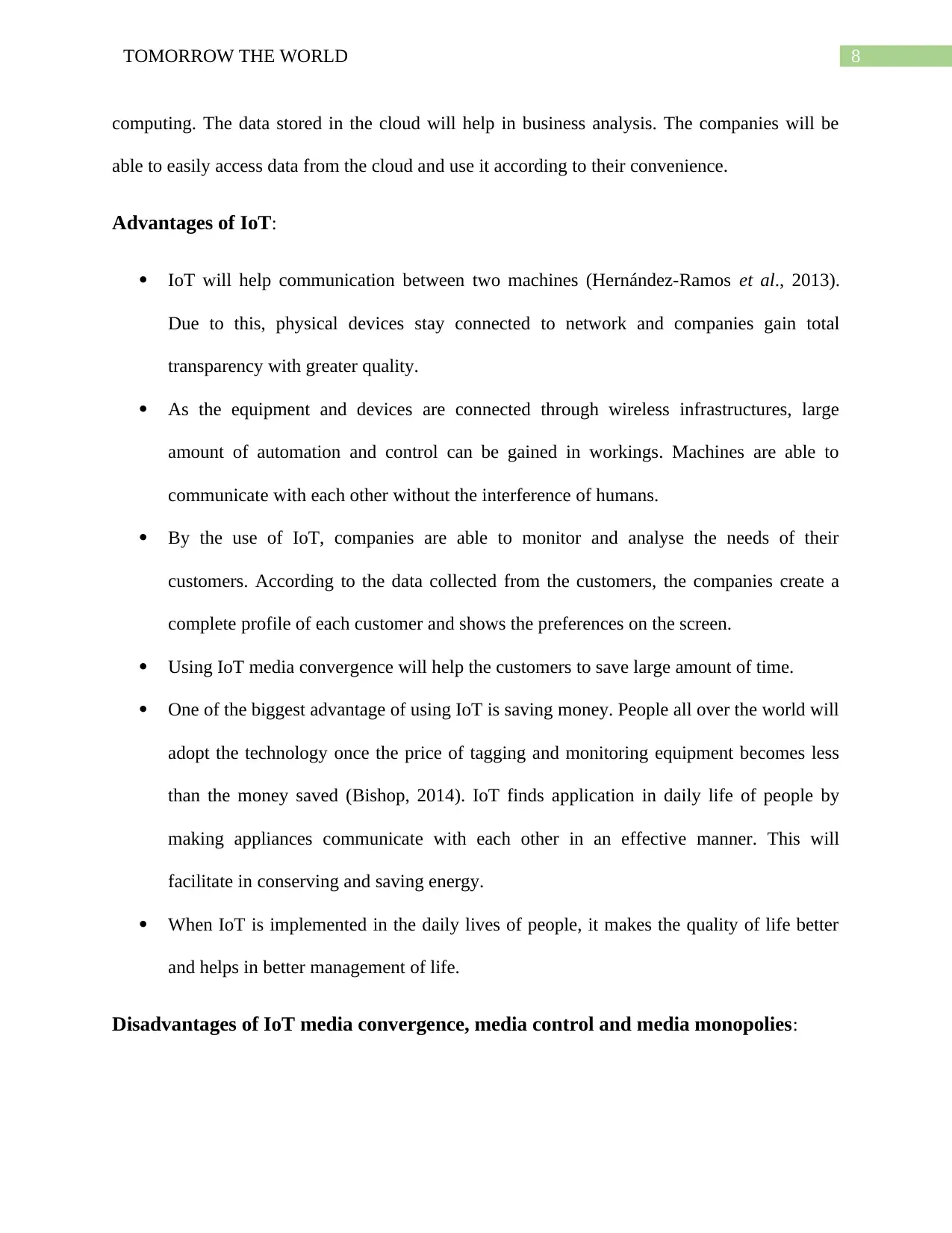
8TOMORROW THE WORLD
computing. The data stored in the cloud will help in business analysis. The companies will be
able to easily access data from the cloud and use it according to their convenience.
Advantages of IoT:
IoT will help communication between two machines (Hernández-Ramos et al., 2013).
Due to this, physical devices stay connected to network and companies gain total
transparency with greater quality.
As the equipment and devices are connected through wireless infrastructures, large
amount of automation and control can be gained in workings. Machines are able to
communicate with each other without the interference of humans.
By the use of IoT, companies are able to monitor and analyse the needs of their
customers. According to the data collected from the customers, the companies create a
complete profile of each customer and shows the preferences on the screen.
Using IoT media convergence will help the customers to save large amount of time.
One of the biggest advantage of using IoT is saving money. People all over the world will
adopt the technology once the price of tagging and monitoring equipment becomes less
than the money saved (Bishop, 2014). IoT finds application in daily life of people by
making appliances communicate with each other in an effective manner. This will
facilitate in conserving and saving energy.
When IoT is implemented in the daily lives of people, it makes the quality of life better
and helps in better management of life.
Disadvantages of IoT media convergence, media control and media monopolies:
computing. The data stored in the cloud will help in business analysis. The companies will be
able to easily access data from the cloud and use it according to their convenience.
Advantages of IoT:
IoT will help communication between two machines (Hernández-Ramos et al., 2013).
Due to this, physical devices stay connected to network and companies gain total
transparency with greater quality.
As the equipment and devices are connected through wireless infrastructures, large
amount of automation and control can be gained in workings. Machines are able to
communicate with each other without the interference of humans.
By the use of IoT, companies are able to monitor and analyse the needs of their
customers. According to the data collected from the customers, the companies create a
complete profile of each customer and shows the preferences on the screen.
Using IoT media convergence will help the customers to save large amount of time.
One of the biggest advantage of using IoT is saving money. People all over the world will
adopt the technology once the price of tagging and monitoring equipment becomes less
than the money saved (Bishop, 2014). IoT finds application in daily life of people by
making appliances communicate with each other in an effective manner. This will
facilitate in conserving and saving energy.
When IoT is implemented in the daily lives of people, it makes the quality of life better
and helps in better management of life.
Disadvantages of IoT media convergence, media control and media monopolies:
⊘ This is a preview!⊘
Do you want full access?
Subscribe today to unlock all pages.

Trusted by 1+ million students worldwide
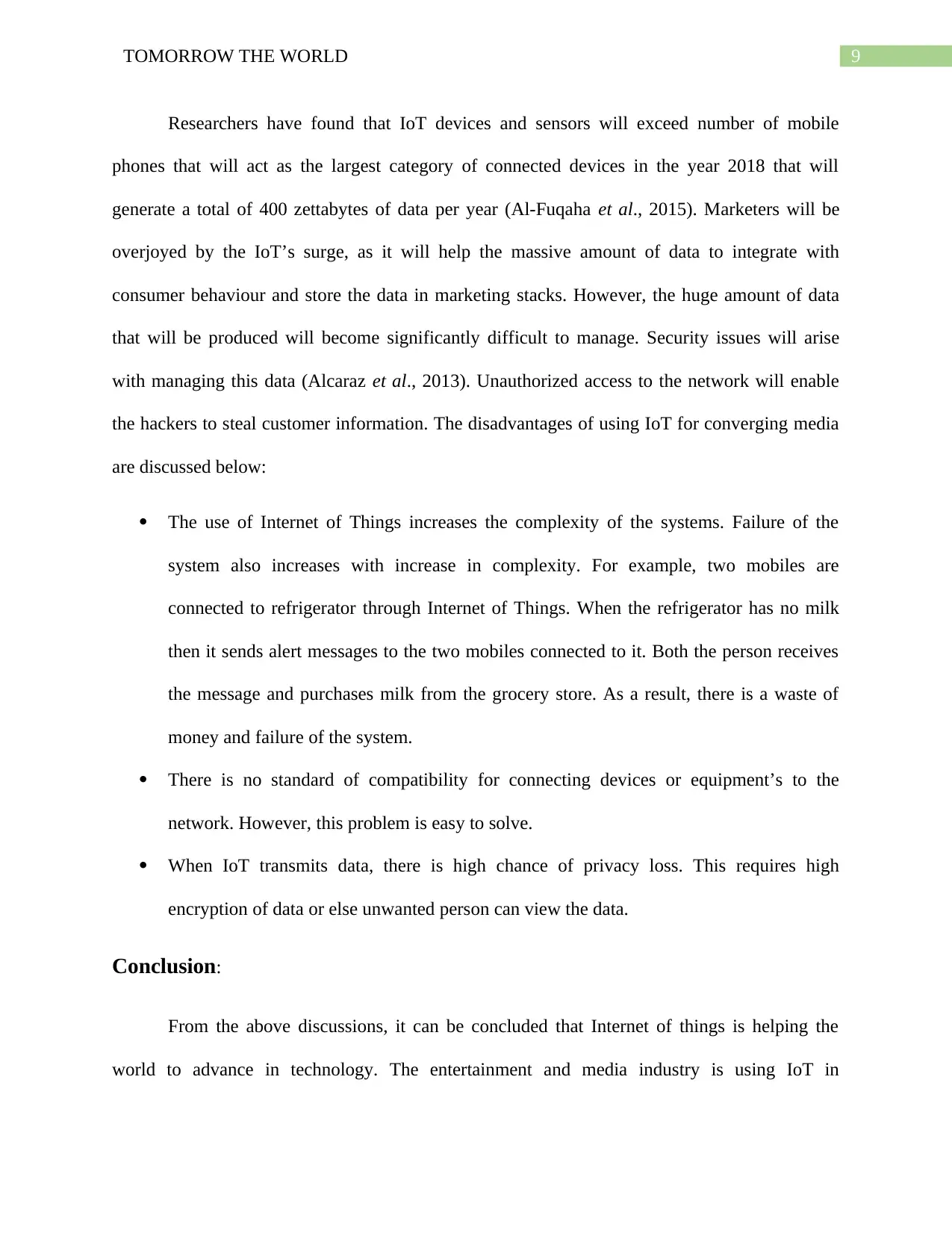
9TOMORROW THE WORLD
Researchers have found that IoT devices and sensors will exceed number of mobile
phones that will act as the largest category of connected devices in the year 2018 that will
generate a total of 400 zettabytes of data per year (Al-Fuqaha et al., 2015). Marketers will be
overjoyed by the IoT’s surge, as it will help the massive amount of data to integrate with
consumer behaviour and store the data in marketing stacks. However, the huge amount of data
that will be produced will become significantly difficult to manage. Security issues will arise
with managing this data (Alcaraz et al., 2013). Unauthorized access to the network will enable
the hackers to steal customer information. The disadvantages of using IoT for converging media
are discussed below:
The use of Internet of Things increases the complexity of the systems. Failure of the
system also increases with increase in complexity. For example, two mobiles are
connected to refrigerator through Internet of Things. When the refrigerator has no milk
then it sends alert messages to the two mobiles connected to it. Both the person receives
the message and purchases milk from the grocery store. As a result, there is a waste of
money and failure of the system.
There is no standard of compatibility for connecting devices or equipment’s to the
network. However, this problem is easy to solve.
When IoT transmits data, there is high chance of privacy loss. This requires high
encryption of data or else unwanted person can view the data.
Conclusion:
From the above discussions, it can be concluded that Internet of things is helping the
world to advance in technology. The entertainment and media industry is using IoT in
Researchers have found that IoT devices and sensors will exceed number of mobile
phones that will act as the largest category of connected devices in the year 2018 that will
generate a total of 400 zettabytes of data per year (Al-Fuqaha et al., 2015). Marketers will be
overjoyed by the IoT’s surge, as it will help the massive amount of data to integrate with
consumer behaviour and store the data in marketing stacks. However, the huge amount of data
that will be produced will become significantly difficult to manage. Security issues will arise
with managing this data (Alcaraz et al., 2013). Unauthorized access to the network will enable
the hackers to steal customer information. The disadvantages of using IoT for converging media
are discussed below:
The use of Internet of Things increases the complexity of the systems. Failure of the
system also increases with increase in complexity. For example, two mobiles are
connected to refrigerator through Internet of Things. When the refrigerator has no milk
then it sends alert messages to the two mobiles connected to it. Both the person receives
the message and purchases milk from the grocery store. As a result, there is a waste of
money and failure of the system.
There is no standard of compatibility for connecting devices or equipment’s to the
network. However, this problem is easy to solve.
When IoT transmits data, there is high chance of privacy loss. This requires high
encryption of data or else unwanted person can view the data.
Conclusion:
From the above discussions, it can be concluded that Internet of things is helping the
world to advance in technology. The entertainment and media industry is using IoT in
Paraphrase This Document
Need a fresh take? Get an instant paraphrase of this document with our AI Paraphraser
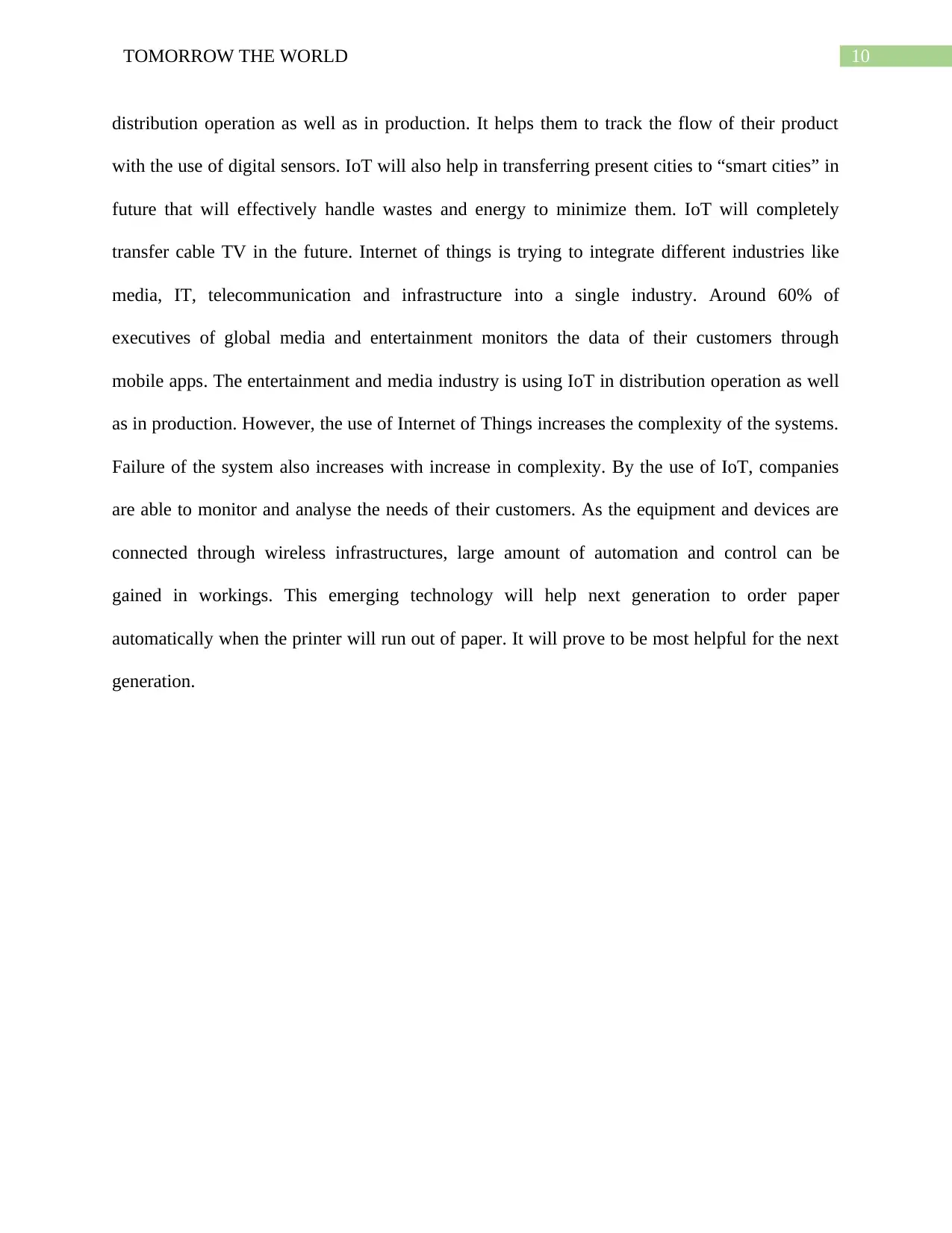
10TOMORROW THE WORLD
distribution operation as well as in production. It helps them to track the flow of their product
with the use of digital sensors. IoT will also help in transferring present cities to “smart cities” in
future that will effectively handle wastes and energy to minimize them. IoT will completely
transfer cable TV in the future. Internet of things is trying to integrate different industries like
media, IT, telecommunication and infrastructure into a single industry. Around 60% of
executives of global media and entertainment monitors the data of their customers through
mobile apps. The entertainment and media industry is using IoT in distribution operation as well
as in production. However, the use of Internet of Things increases the complexity of the systems.
Failure of the system also increases with increase in complexity. By the use of IoT, companies
are able to monitor and analyse the needs of their customers. As the equipment and devices are
connected through wireless infrastructures, large amount of automation and control can be
gained in workings. This emerging technology will help next generation to order paper
automatically when the printer will run out of paper. It will prove to be most helpful for the next
generation.
distribution operation as well as in production. It helps them to track the flow of their product
with the use of digital sensors. IoT will also help in transferring present cities to “smart cities” in
future that will effectively handle wastes and energy to minimize them. IoT will completely
transfer cable TV in the future. Internet of things is trying to integrate different industries like
media, IT, telecommunication and infrastructure into a single industry. Around 60% of
executives of global media and entertainment monitors the data of their customers through
mobile apps. The entertainment and media industry is using IoT in distribution operation as well
as in production. However, the use of Internet of Things increases the complexity of the systems.
Failure of the system also increases with increase in complexity. By the use of IoT, companies
are able to monitor and analyse the needs of their customers. As the equipment and devices are
connected through wireless infrastructures, large amount of automation and control can be
gained in workings. This emerging technology will help next generation to order paper
automatically when the printer will run out of paper. It will prove to be most helpful for the next
generation.
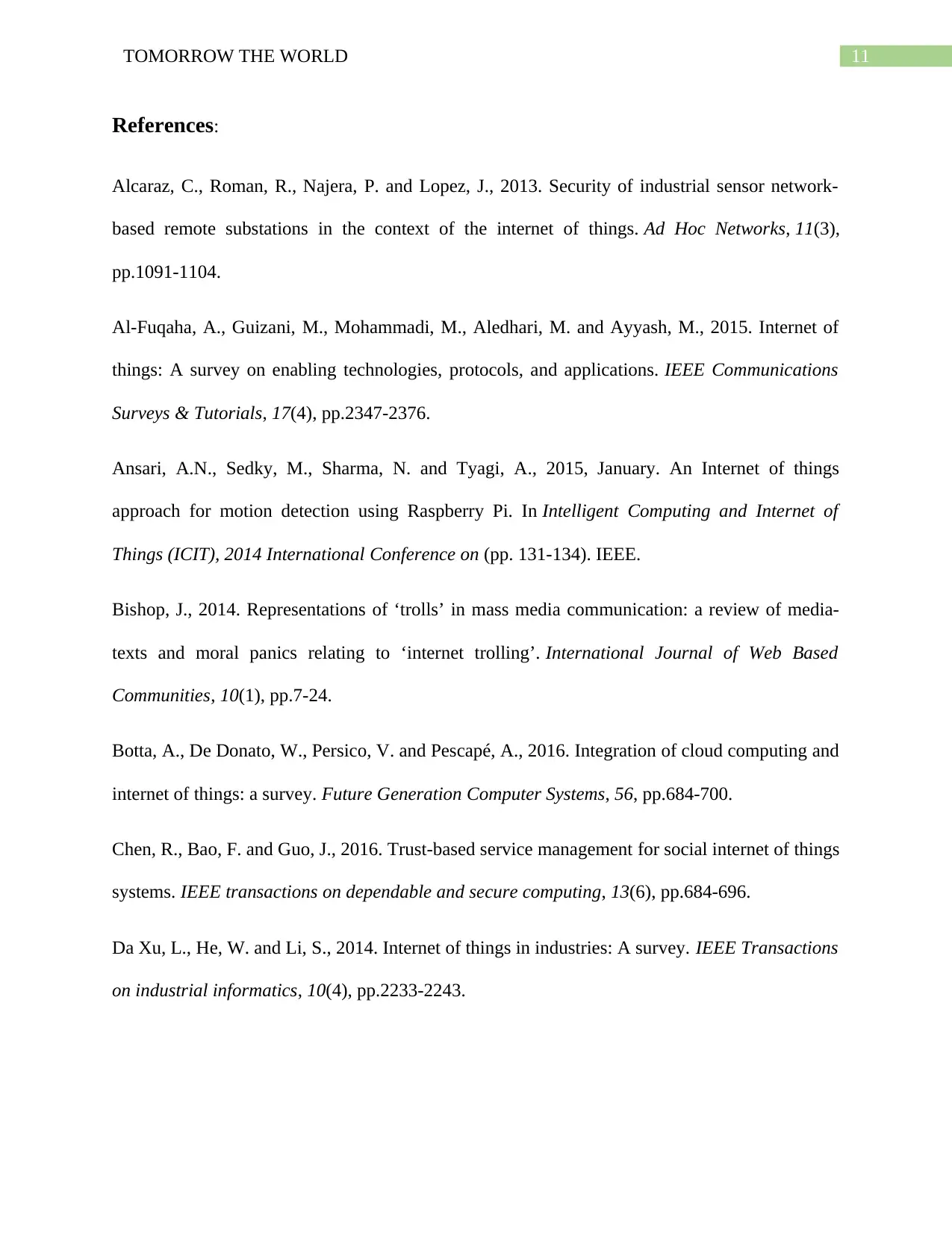
11TOMORROW THE WORLD
References:
Alcaraz, C., Roman, R., Najera, P. and Lopez, J., 2013. Security of industrial sensor network-
based remote substations in the context of the internet of things. Ad Hoc Networks, 11(3),
pp.1091-1104.
Al-Fuqaha, A., Guizani, M., Mohammadi, M., Aledhari, M. and Ayyash, M., 2015. Internet of
things: A survey on enabling technologies, protocols, and applications. IEEE Communications
Surveys & Tutorials, 17(4), pp.2347-2376.
Ansari, A.N., Sedky, M., Sharma, N. and Tyagi, A., 2015, January. An Internet of things
approach for motion detection using Raspberry Pi. In Intelligent Computing and Internet of
Things (ICIT), 2014 International Conference on (pp. 131-134). IEEE.
Bishop, J., 2014. Representations of ‘trolls’ in mass media communication: a review of media-
texts and moral panics relating to ‘internet trolling’. International Journal of Web Based
Communities, 10(1), pp.7-24.
Botta, A., De Donato, W., Persico, V. and Pescapé, A., 2016. Integration of cloud computing and
internet of things: a survey. Future Generation Computer Systems, 56, pp.684-700.
Chen, R., Bao, F. and Guo, J., 2016. Trust-based service management for social internet of things
systems. IEEE transactions on dependable and secure computing, 13(6), pp.684-696.
Da Xu, L., He, W. and Li, S., 2014. Internet of things in industries: A survey. IEEE Transactions
on industrial informatics, 10(4), pp.2233-2243.
References:
Alcaraz, C., Roman, R., Najera, P. and Lopez, J., 2013. Security of industrial sensor network-
based remote substations in the context of the internet of things. Ad Hoc Networks, 11(3),
pp.1091-1104.
Al-Fuqaha, A., Guizani, M., Mohammadi, M., Aledhari, M. and Ayyash, M., 2015. Internet of
things: A survey on enabling technologies, protocols, and applications. IEEE Communications
Surveys & Tutorials, 17(4), pp.2347-2376.
Ansari, A.N., Sedky, M., Sharma, N. and Tyagi, A., 2015, January. An Internet of things
approach for motion detection using Raspberry Pi. In Intelligent Computing and Internet of
Things (ICIT), 2014 International Conference on (pp. 131-134). IEEE.
Bishop, J., 2014. Representations of ‘trolls’ in mass media communication: a review of media-
texts and moral panics relating to ‘internet trolling’. International Journal of Web Based
Communities, 10(1), pp.7-24.
Botta, A., De Donato, W., Persico, V. and Pescapé, A., 2016. Integration of cloud computing and
internet of things: a survey. Future Generation Computer Systems, 56, pp.684-700.
Chen, R., Bao, F. and Guo, J., 2016. Trust-based service management for social internet of things
systems. IEEE transactions on dependable and secure computing, 13(6), pp.684-696.
Da Xu, L., He, W. and Li, S., 2014. Internet of things in industries: A survey. IEEE Transactions
on industrial informatics, 10(4), pp.2233-2243.
⊘ This is a preview!⊘
Do you want full access?
Subscribe today to unlock all pages.

Trusted by 1+ million students worldwide
1 out of 15
Related Documents
Your All-in-One AI-Powered Toolkit for Academic Success.
+13062052269
info@desklib.com
Available 24*7 on WhatsApp / Email
![[object Object]](/_next/static/media/star-bottom.7253800d.svg)
Unlock your academic potential
Copyright © 2020–2025 A2Z Services. All Rights Reserved. Developed and managed by ZUCOL.




